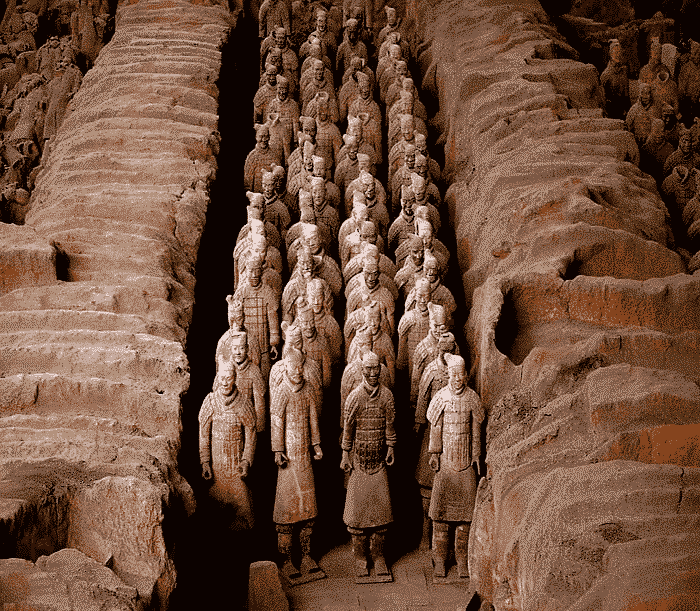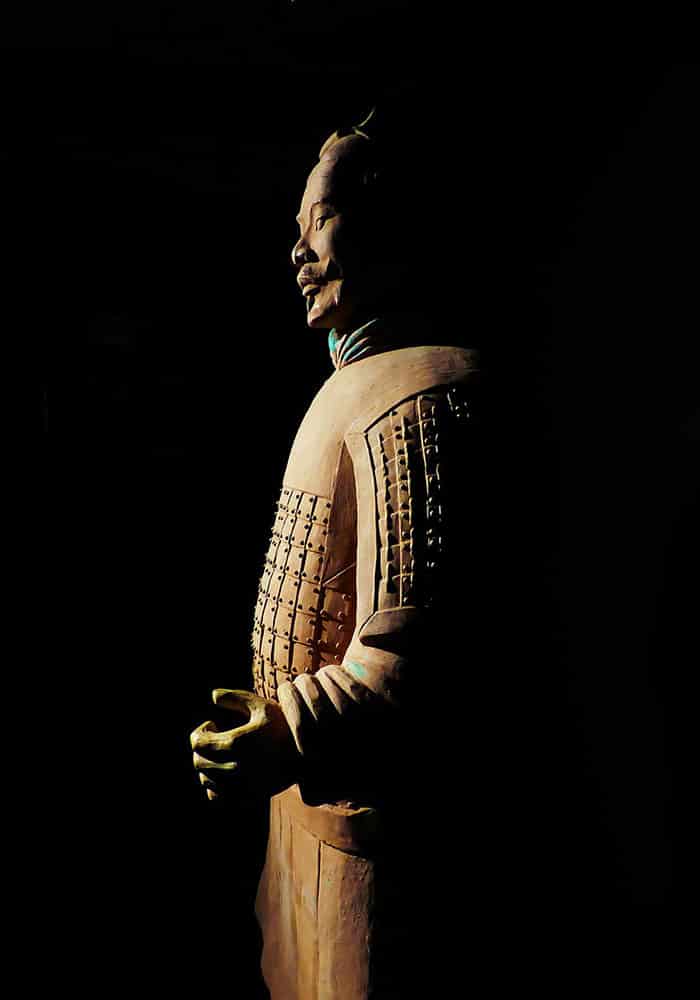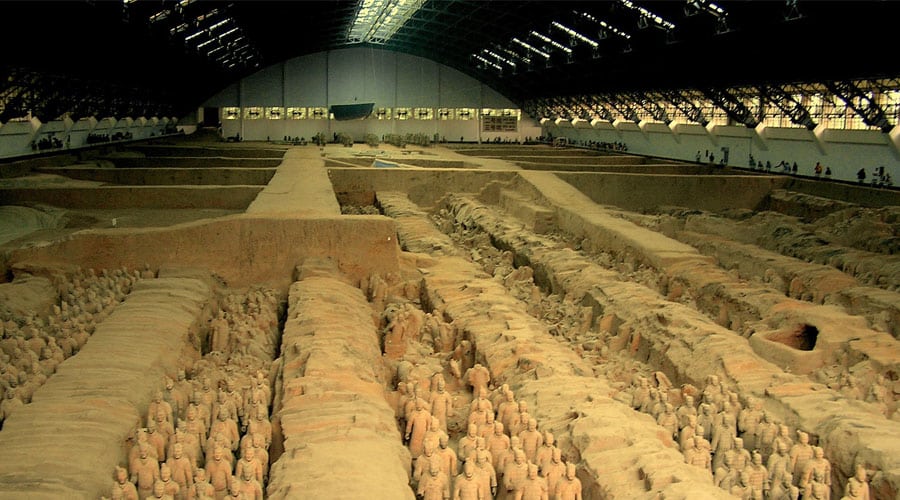The Terracotta Army of Xian, famously known as Terracotta Warriors and Horses, is a massive collection of outstanding life-size terracotta sculptures. These were made to replicate a battle formation, which resembles the mega imperial guard troops of Emperor Qin Shi Huang (259 – 210 BC). He is known to be the first emperor to rule the unified dynasty of Imperial China.
It is considered as the most noteworthy and substantial archeological excavation of the 20th century. Moreover, it is a recognized UNESCO World Heritage site. Terracotta Army is a tourist spot worth visiting in Xian. It was initially planned as the historical funerary project for Emperor Qin Shi Huang. Then it developed to be a live museum and then, it was called Emperor Qinshihuang’s Mausoleum Site Museum. The museum offers the life and reign stories of the emperor as well as the very influential Qin Empire (221 – 207 BC). (Video Credit: Milosh Kitchovitch)
Terracotta Army Facts
Terracotta Army as The Eighth Wonder of The World
The Terracotta Army was regarded as the Eighth Wonder of the World by the former French Prime Minister Chirac in 1978 due to its huge pits and magnificently carved 8,000 figures and horses. It was discovered in 1974 and awarded as a UNESCO World Heritage Site in 1987.
2,200 Years of Qin history
The army signifies the 2,200 years of Qin history. It was the period of the entire unification of China in which, a powerful and abundant dynasty was successfully established. With a population of 20 million, an annual income of 2,000 kilograms worth of sliver, military advantage, and economic advantage, the dynasty was able to create the funerary project for the emperor’s mausoleum. However, in 208 BC, the mausoleum construction was stopped and buried to the ground.
It was discovered in March of 1974 and buried 1.5 km to the east of Qin Shi Huang Mausoleum mound. Local farmers were digging a well in wasteland near Xiyang Village when one digger excavated one of the life-sized warriors.
Qin Shihuang Construction Order
Emperor Qin Shihuang ordered the construction of the massive Terracotta Army to guard him in his afterlife. It was Prime Minister Li Si who designed the construction and senior general Zhang Han who supervised the men at work. Workers are mostly artisans and potters.
Well-Known People Who Visited The Museum
Many well-known celebrities and leaders have already visited the site. They have delivered profound messages to show their appreciation and awe after seeing the Terracotta Army. Some of them are former Prime Minister Lee Kuan Yew of Singapore, former President Jacques Chirac of France, former Presidents Ronald Reagan and Bill Clinton of the United States, and President Vladimir Putin of Russia.

Must-Sees
Museum of Qin Terracotta Warriors and Horses
The warriors and horses are located in 3 major pits.
Pit 1
Pit 1 is the largest one, which was discovered in 1974 and opened to the public on Oct. 1st, 1979. Here, the three-row frontline of the army, the huge battle formation of infantry, and war chariots can be seen.
Pit 2
Pit 2 was founded in 1976. It is located 20 meters northeast of the first discovered pit. It is the most brilliant one for the assortment of divisions such as infantry, crossbow team, cavalry, and 80 chariots.
Last Pit
The last pit was discovered in 1976, which is located 25 meters northwest of Pit No. 1. It is the pit for the armed forces’ command post. It has 68 warriors and a chariot with four horses.
To fully appreciate and examine the intricate details of the formations and sculptures, a visitor must set aside 2 to 4 hours in this section of the museum.

Qin Shi Huang’s Mausoleum Site Park (Lishan Garden)
Pit K0006 – Civil Official Figures
It was discovered by the museum’s archaeologists in 2000. It is an accessory pit that houses 12 pottery figures. Due to the 8 civil officials included in the pottery, the pit was called Civil Official Figures Pit.
Pit K0007 – Bronze Aquatic Birds
In 2000, the pit K0007 was found. There were the farmers of a nearby village who first discovered this fit which was considered as the farther accessory pit to date. More excavation revealed bronze aquatic birds, thus, it was named Bronze Aquatic Birds Pit. Though Pit K0007 is closed for public viewing, visitors can still see the aquatic birds in the Exhibition Hall of Historical Relics of Emperor Qin Shihuang’s Mausoleum near Pit 1.
Pit K9801 – Stone Armor and Helmets
This accessory pit was discovered in 1996 by a farmer of Xiachen Village. The excavated relics are mostly stone armor and helmets; therefore, the name Stone Armor Pit. This portion of the museum is not yet open to the public but the excavated items can be viewed in the Exhibition Hall of Historical Relics of Emperor Qin Shihuang’s Mausoleum.
Pit K9901 – Acrobatics Figures
This pit is located in the southeast portion of the Qin Shi Huang Mausoleum discovered in the year 1999 when eleven acrobatic figures painted in colors and a bronze tripod were unearthed. K9901 has a unique shape of “凸”, a Chinese character, with a 40-meter stretch from east to west.

Good to Know
Emperor Qin Shi Huang started preparing the mausoleum at the age of 13, immediately after ascending to the throne. It took 11 years for the workers to finish the mausoleum. It is believed that the mausoleum contains various treasures and sacrificial items. Probably the most extravagant masterpiece is the Terracotta Army who guards Emperor Qin Shi Huang in his afterlife.
Different Kinds of Terracotta Statues
There are different kinds of Terracotta Statues such as infantry warriors, cavalry warriors, chariot warriors, kneeling archers, standing archers, etc.
Bronze Weapons
There were around 40,000 bronze weapons discovered in the pits. The best weapons of the Terracotta Army are swords, billhooks, spear, dagger-ax, halberd, battle-ax, shu, bayonet, crossbow, and arrowhead.
Clothing
The warriors have different clothing depending on their ranks. The officers wear an intricately made headgear, single or double-layered gowns with length up to the knee, pants, shoes, which has a colorful armor covering their body. While the terracotta soldiers wear a knee-length gown, an armor, a hat, pants, and boots.
Tourist Guide
[wpsm_colortable color=”main-color”]
| From downtown Xian | |
|---|---|
| By Bus (From Xian Railway Station) | The tourists coming from the Xian Railway Station can take the bus line 5 (306). Travel time is approximately 60 minutes and it costs CNY 7 per person. |
| By Bus (From Tang City Wall Zone) | Another bus, 307, travels from Tang City Wall Zone 9 Bus Station to the museum. Travel time is 90 minutes and costs CNY 8 per person. The bus will pass by the Tang Paradise, Big Wild Goose Pagoda, Banpo Museum Bus Hub, and Huaqing Palace. |
| By Taxi | Traveling by taxi is also possible. Getting to the museum by taxi usually takes 40-50 minutes and costs CNY 150. |
| from Xian Airport | |
| By Shuttle Bus | There is an airport shuttle bus to the Xian Railway Station. Travel time to the station is 60 minutes. From there, the visitor can take the tourist bus line 5 (306) and will reach the museum in an hour. |
| By Shuttle Bus | Another shuttle bus leaves the airport to go to Lintong. Travel time is 60 minutes. Upon reaching Lintong, the tourist can transfer to a bus, Lintong 101, to go to the museum in 20 minutes. |
| By Taxi | Plenty of taxis are also available at the airport. Travel time is approximately 70 minutes and it would cost the traveler around CNY 200. |
| from Xian North Railway Station | |
| By Shuttle Bus | There are free shuttle buses in the North Railway Station. Travel time is 60 minutes. |
| By Taxi | There are also taxis in the area which would cost CNY 160 and could take the travelers to the museum in 60 minutes. |
| From Beijing / Shanghai / Hong Kong | |
| By Flight | There are various flights from these cities to Xian. The visitors can choose a flight and later take any of the routes mentioned above. |
| High-Speed Trains | Another option is to take the high-speed trains to the Xian North Railway Station. Though the traveling time will be longer |
[/wpsm_colortable]
Prices
[wpsm_colortable color=”main-color”]
| Prices | |
|---|---|
| Adults | 150 Yuan from March to November and 120 Yuan from December to February |
| Children Taller Than 4.9 Feet | 75 Yuan from March to November and 60 Yuan from December to February |
| Children Under 4.6 feet | Free |
| Foreign Students in China | 75 Yuan from March to November and 60 Yuan from December to February (with valid student ID card) |
| Audio Guide | |
| Rent | 40 Yuan |
| Deposit | 100 Yuan |
[/wpsm_colortable]
Opening Hours
[wpsm_colortable color=”main-color”]
| Opening Hours | |
|---|---|
| March 16 to November 15 | 8:30 – 18:00 |
| November 16 to March 15 | 8:30 – 17:30, ticketing stops at 16:30. |
[/wpsm_colortable]

It should be mentioned that IDs or passports are needed in purchasing tickets or entering the museum; therefore, don’t forget to bring them. Besides, if you need to get more information, you can be in touch with the museum using the phone number +86 29 8139 9001. Finally, we will be grateful if you share your information and thoughts with us.





